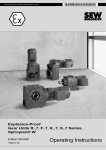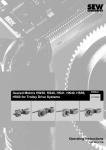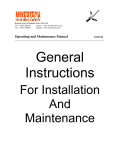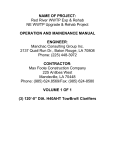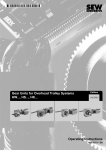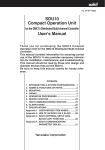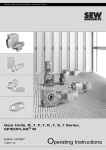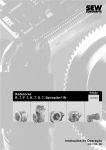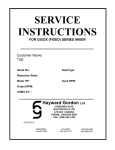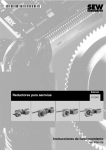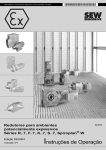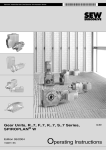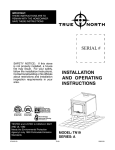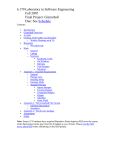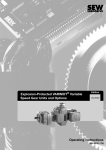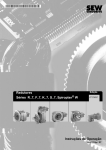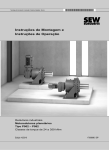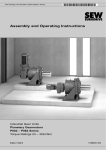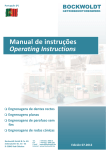Download HRF Manual - Hayward Gordon Ltd
Transcript
SERVICE INSTRUCTIONS FOR HRF SERIES MIXER Customer Name: Tag: Serial No.: Size/Type: Reduction Ratio: Motor HP: Input RPM: Output RPM: AGMA S.F.: Hayward Gordon Ltd. 5 BRIGDEN GATE HALTON HILLS, ON L7G 0A3 CANADA PHONE: (905) 693-8595 FAX: (905) 693-1452 OFFICES IN: MONTREAL 514-697-6445 CALGARY 403-253-2737 VANCOUVER 604-986-8764 HAYWARD GORDON LTD HRF Series Mixers Page 1 Rev: 1 Date 11/99 Section: RF TABLE OF CONTENTS Initial inspection ...................................................................................................... 3 Storage General ........................................................................................................ 3 Motors and Gear Drives............................................................................... 3 Seals ........................................................................................................... 4 Shafts and Impellers .................................................................................... 4 Installation and Operation General ........................................................................................................ 4 Mixer Assembly............................................................................................ 5 Mounting ...................................................................................................... 5 Motors .......................................................................................................... 6 Gear Drives .................................................................................................. 6 Seals ........................................................................................................... 6,7 Shafts and Impellers .................................................................................... 7,8 Lubrication Bearings ....................................................................................................... 9 Motors and Gear Drives............................................................................... 9 Seals ........................................................................................................... 9 Maintenance Motors .......................................................................................................... 10 Gear Drives .................................................................................................. 10 Trouble Shooting..................................................................................................... 11,12 APPENDIX ........................................................................................................... 13 Parts Lists .................................................................................................... 14 Impeller Blade Bolt and Set Screw Torque.................................................. 15 Stuffing Box Instructions .............................................................................. 16 Stuffing Box, High Pressure......................................................................... 17 Single Mechanical Seal................................................................................ 18 Double Mechanical Seal .............................................................................. 19 Commissioning and Service Copyright 2002 © Hayward Gordon Limited Specifications subject to change without prior notice HAYWARD GORDON LTD HRF Series Mixers Page 1 Rev: 1 Date 11/99 Section: RF HRF MODEL NUMBERING HRF mixers have model numbers of the format; HRFX -_ _ -_ _ _ The digits in underscore indicate numeric placeholders and provide specific information to Hayward Gordon. Depending on the features of your HRF mixer there may be the letter "S" or the letter "M" following HRF in the model number. HRFX models include baseplate with lip seal. HRFS models include mounting flange with stuffing box. HRFM models include mounting flange with mechanical seal. Please provide complete Mixer Model Number and Mixer Serial Number when information or service is required. This information should be copied from the mixer nameplate to the front cover of this Service Manual. HAYWARD GORDON LTD HRF Series Mixers Page 2 Rev: 1 Date 11/99 Section: RF INITIAL INSPECTION Care should be exercised in uncrating and handling. Miscellaneous parts (turbine hubs, turbine blades, fasteners, coupling hubs, etc.) may be boxed separately and attached to the crate or may be wired or bolted to the crate. DO NOT DISCARD CRATE without carefully making sure that all mixer parts have been removed. The unit should be inspected carefully and any shipping damage reported to Hayward Gordon Limited. A claim should be filed immediately with the carrier involved. Damage resulting from improper handling can affect the operation and life of your Hayward Gordon mixer. Particular care should be taken to prevent bending the shaft, which has been straightened within a few thousandths of an inch. Never lift or support the unit by the end of the shaft. STORAGE GENERAL For storage of the mixer, do not remove the protective coating. Add additional protective coating as may be required for condition and period of storage. MOTORS and GEAR DRIVES Hayward Gordon strongly recommends that mixer gear drives be kept in a dry, temperature controlled indoor storage area. Mixer drives must be sealed from the atmosphere during storage, make sure breathers are replaced by plugs. Store mixers such that the gear drives are in their normal vertical configuration and fill the gear case completely with the proper grade of oil. Rotate input or output shaft several revolutions each month. If these conditions are carefully maintained, storage durations of up to two years are possible. If an indoor area is not available with temperature and humidity control, the next best option is indoors without these controls. In this case, wrap the motor in plastic with desiccant bags inside and replace the desiccant bags monthly. Outdoor storage is not recommended. If outdoor storage is unavoidable, keep all of the mixer components off the ground on skids or platforms and cover the equipment with a waterproof covering. Wrap the motor in plastic with desiccant bags inside and replace the desiccant bags monthly. SEALS Double mechanical seal housings and mechanical seal lubricators are shipped from the factory coated internally with a rust preventative which is compatible with most sealing fluids. The components as shipped are adequately protected for short-term storage in heated indoor environment. Outdoor storage of mechanical seal units is not recommended; however, when HAYWARD GORDON LTD HRF Series Mixers Page 5 Rev: 1 Date 11/99 Section: RF unavoidable the seal housing and lubricator pot should be completely filled with a lubricant compatible with the sealing fluid to be used in service. SHAFTS and IMPELLERS The shaft shipped with your unit was straightened at the factory to within a few thousandths of an inch. Care should be taken in the storage of the shaft to see that it is fully supported along its entire length and to see that heavy items are not placed on unsupported sections of the shaft. For outdoor storage of carbon steel shafts and impellers, a suitable grease or rust preventative should be applied to the parts. INSTALLATION AND OPERATION GENERAL Proper installation and operation is the key to long trouble free mixer service. The following is a list of points to cover during installation and operation: 1. 2. 3. 4. 5. 6. 7. 8. Ensure the mixer rotation is correct before permanently wiring the motor. Read all tags, nameplates and this manual prior to operating the unit. Check motor operating amperage against motor nameplate amperage. Do not operate in a fluid with a specific gravity or viscosity higher than that for which the unit is designed. Do not attempt to start a unit with the impeller buried in solids or in a "set up" fluid. Maintain operating temperatures and pressures of vessel within design limitations for stuffing box and mechanical seal units. A minimum of 4" radial clearance must be maintained between the impeller and any obstruction. Any anticipated changes in motor horsepower, mixer speed, shaft length, impeller diameter or blade width, etc. should be discussed with Hayward Gordon prior to making changes. MIXER ASSEMBLY All units are completely assembled except for the following items: 1. The extension shaft must be inserted through the lower bearing replacing the snap ring on the shaft and coupling the shaft with the sleeve coupling. All setscrews are then to be tightened, refer to page 14 for diagram. 2. Impellers turning at speeds higher than 100 RPM are statically balanced and are to be assembled according to the match marks. Values shown in Table III (pg. 8) indicate torquing requirements. 3. Mixers supplied with in-tank couplings are to be assembled using the hardware supplied and torqued to values shown in Table III (pg. 8). HAYWARD GORDON LTD HRF Series Mixers Page 2 Rev: 1 Date 11/99 Section: RF Open tank models are mounted separately from the tank on a steel structure. These units include an integral lip seal and bearing cartridge in the base plate. Stuffing box models mount with a standard ANSI flange to a nozzle or pad directly on the vessel. Mechanical seal models mount with a standard ANSI flange to a nozzle or pad directly on the vessel. EXTREME CARE SHOULD BE TAKEN IN HANDLING AND IN INSTALLING TO ENSURE THAT THE SHAFT IS NOT JARRED, CAUSING DAMAGE TO THE DELICATE MECHANICAL SEAL PARTS. MOUNTING Mixers are mounted in the vertical position only and care should be taken to level the support structure or nozzle. The mixer itself has been designed to accept the bending moments and torque reactions produced by the impeller(s) operating in the fluid. These loads will be transmitted to the support and therefore the mounting system must be strong enough to support all the loads produced by the mixer. The support structure must also be rigid enough to prevent dynamic deflections greater than 0.25° in any direction. Size the support structure to accommodate the bending moment, torque reaction and static weight shown on the general arrangement drawing. MOTORS Ample circulation of air during operation is very important in obtaining full performance and long life from an electric motor. Minimize obstructions to free circulation in areas where motors are installed. Avoid choking off the suction inlets on fan cooled motors. The life of the motor will be decreased if its temperature during operation exceeds its nameplate ambient rating. Overload protection should always be provided to avoid motor damage during temporary overloads, jams or other mishaps. Prior to permanently wiring the electric motor, check the output shaft rotation with the rotation indicated on the drive nameplate. DO NOT OPERATE UNIT WITHOUT CHECKING ROTATION. For standard 3 phase motors the rotation may be reversed by changing any two leads. For complete details, refer to the attached manufacturer's manual. GEAR DRIVES The gear drive has been shipped from the factory filled with the proper grade and quantity of oil. The reducer is provided with a red painted level plug, a drain plug located at its lowest spot and a blue painted plug indicating the location for the breather. The breather is shipped in a plastic bag attached to the gearbox. In the case of gear motors the breather plug is shipped inside the motor terminal box. When the installation of the drive is completed, the blue plug, located at the highest HAYWARD GORDON LTD HRF Series Mixers Page 2 Rev: 1 Date 11/99 Section: RF spot on the reducer, is to be replaced with the breather. Before starting the unit, check for correct oil level by removing the red oil level plug. A small amount oil should trickle from this opening. Refer to the attached manufacturer's literature for complete details of the gear reducer. SEALS Open tank models are supplied with an integral lip seal and bearing in the mounting plate. The main purpose is to prevent any contaminants from running down the shaft into the tank and keeping process fluid splash from contacting the drive. This seal may also be used to seal atmospheric vapours. Stuffing box seals consist of six rings of packing and a lantern ring. Extreme care during installation and operation is required if proper packing life is to be realized. The lantern ring distributes lubricant to the packing during operation. Prior to operation, remove the relief plug, and using lubricant which is compatible with the process fluid, pump the lube into the fitting until lubricant is evident at the relief. After allowing the packing to "run-in", the gland plate nuts should be snugged but do not over tighten. HAYWARD GORDON LTD HRF Series Mixers Page 7 Rev: 1 Date 11/99 Section: RF Mechanical seal models can be supplied with double face type rotary seals, which must be lubricated or with single dry running type which are self-lubricating. Double mechanical seals require fluid lubrication either DEAD ENDED or CIRCULATED through the seal chamber at a pressure 20 PSI above or 10% higher than the maximum pressure that will be in the mixing tank. For longest seal life, light mineral oil is the best choice as a seal lubricant. Many processes, however, cannot permit even the slightest oil contamination. In these instances, we recommend that one of the process components or a compatible fluid be used. The chosen lubricant MUST NOT attack the seal components or seal housing. If water is used as the lubricant, we recommend that a corrosion inhibitor or a small amount of glycerin be added to the water to improve its lubricity. For maximum seal life, we recommend that the temperature of the seal lubricant be kept below 150°F for oil, 125°F for water and 100°F for solvents with a SG of less than 0.7. In most cases, the absolute max temperature of the lubricant, to avoid seal failure, is 350°F. The seal chamber pressure must always be greater than the pressure in the mixing vessel. Therefore, DO NOT add pressure to the vessel until the seal chamber has been pressurized. It is very important for satisfactory seal performance that no air is trapped in the seal housing ensure that all air has been bled from the system before starting up unit. The seal lubricator level should be checked regularly and refilled as necessary. Good operating practice is to flush the lubrication system every 5000 hours or every 12 months, which ever occurs first. If the unit has been supplied with a single dry running seal, consult the enclosed manufacturer's literature. SHAFTS AND IMPELLERS The extension shaft of your Hayward Gordon Mixer was straightened to within a few thousandths of an inch prior to shipment from the factory. Care should be taken when handling the shaft to see that it is not bent. After the unit is installed the shaft straightness should be checked. Total shaft run-out at the end of the shaft should not exceed 0.003" per foot of shaft extension. If the shaft run-out is greater than the above figure, the shaft can be straightened in the field. Place an indicator on the side of the shaft where the maximum positive reading is obtained. Apply heat to the shaft at a point 180° from the indicator and just below the first in-tank coupling or mounting flange. As heat is applied - do not allow surface temperature to exceed 450°F (dark straw to bluish color) - the shaft will grow toward the indicator. After the shaft has grown 0.030"-0.060", remove heat and shaft will draw away from the indicator. The draw will be greater than the growth. After each heating process, recheck the shaft straightness until within tolerance. HAYWARD GORDON LTD HRF Series Mixers Page 8 Rev: 1 Date 11/99 Section: RF Hayward Gordon produces a variety of impeller designs for a broad range of mixing applications. The impeller assembly normally consists of two parts: the hub, which is fastened to the shaft by means of a pinned key, and blades, which are bolted to the hub ears ( pg. 15 ). Mixers are normally shipped with the hub(s) mounted on the mixer shaft and blades shipped separately. Impellers which are designed to turn at speeds higher than 100 RPM will be match marked at the factory - ensure that match marks are located and assembled accordingly. In-tank fasteners are supplied either with lock washers or double nuts. Care should be taken to see that locking devices are properly installed and bolts properly tightened. It is recommended that all in-tank fasteners be rechecked for tightness after the first 1500 hours of operation and subsequently at each shutdown period. Table III gives torque values to which all shaft and impeller bolts should be tightened. TABLE III Thread Size ¼”-20UNC 5/16”-18 UNC 3/8”-16 UNC ½”-13 UNC 5/8”-11 UNC ¾”-10 UNC 7/8”-9 UNC 1”-8 UNC Torque Values (ft.-lbs.) Dry Lubricated 4.5 6 9.5 12 15 20 40 55 85 110 135 180 200 260 270 350 HAYWARD GORDON LTD HRF Series Mixers Page 9 Rev: 1 Date 11/99 Section: RF LUBRICATION BEARINGS The bearing located in the pedestal area of the mixer has been lubricated prior to shipment from the factory; however, at 6-8 month intervals the bearing should be re-greased. Using the grease fitting supplied, add grease slowly with shaft turning until a slight bead forms at the lip seal. The grease used should be a high grade, non-separating, ball bearing grease of NLGI No. 2 consistency suitable for operating temperatures to 200oF. Grease should be non-reactive, oxidation resistant to ball bearings and should not separate below 300oF. It should not precipitate sediment or contain grit, abrasives or fillers. MOTORS and GEAR DRIVES Motor bearings are provided with sealed grease packing and do not have grease fittings. Refer to the attached Manufactures literature for further details. The mixer drive oil should be changed every 10,000 hours of operation or every 2 years which ever is shorter. Under extreme environmental conditions or very high operating loads, more frequent oil changes are recommended. If your mixer operates under such conditions, you must pay special attention to regular oil changes and to inspecting the oil for evidence of deterioration. If your mixer operates under any of the following conditions, more frequent oil changes will be necessary. 1.Heavy intermittent loads that cause the mixer drive housing temperature to rise rapidly, and then cool when loads decrease. 2.Ambient temperature and humidity conditions that could cause moisture condensation on the inside walls of the mixer drive. 3.Oil temperatures during mixer operation that exceed 200oF 4.Mixer drive exposure to unusually dusty atmospheres, or to corrosive or reactive vapors. SEALS Stuffing box seals equipped with a lantern ring, lube fill fitting and a lube relief plug, should be re-lubricated on a regular basis - 2-3 month intervals for maximum performance. Remove the lube relief plug and add new lubricant at the lube fill fitting until new grease is evident at the relief. Reinsert the relief plug. Any fluid with grease like viscosity, which is compatible with the process fluid may be used as stuffing box lubricant. Mechanical seals require that the seal cavity at all times be filled with proper lubricant for satisfactory operation - see INSTALLATION, Seals. The lubricant can be any low viscosity fluid with reasonable lubricity which is compatible with the process fluid and which is stable over the full range of pressures and temperatures at which the seal will be operated. Common seal lubricants are light mineral oil, ethylene glycol and demineralized water with glycerine. HAYWARD GORDON LTD HRF Series Mixers Page 10 Rev: 1 Date 11/99 Section: RF MAINTENANCE MOTORS Each motor should be inspected at regular intervals. The frequency and degree of thoroughness depends upon the environment and nature of service. The following suggested check list requires only a few minutes and may result in considerable savings if followed regularly. 1. Cleanliness - coatings of dirt, dust and grease retard the flow of heat to the atmosphere and may cause overheating. Wipe the motor clean and apply an inhibitor to rusted parts. 2. Temperature - allowable temperature is stamped on the motor nameplate. Overheating indicates overloading, shorts or burned insulation. 3. Moisture - be sure motor is dry, inside and out, totally enclosed motors may accumulate condensation under certain conditions. Most motors are equipped with a plugged hole to permit drainage. 4. Noise - unusual noises from a motor mean trouble. This may be the first indication of a failing bearing or loose connection. GEAR DRIVES Other than periodic lubrication as outlined in the LUBRICATION section, no routine operational gear drive maintenance is required. In order to assure the longest life from your drive, annual shut downs which can correspond with plant shut downs should be planned. Gear tooth contact and wear patterns, shaft/bearing end play, alignment, bolting and condition of all seals should be checked. HAYWARD GORDON LTD Page 11 Rev: 1 Date 11/99 Section: RF HRF Series Mixers TROUBLE SHOOTING The mixer should be checked often for abnormal temperatures, oil leaks, abnormal noise, vibration etc. In the event of difficulties, the unit should be shut down immediately. The following trouble shooting table should be reviewed and if no solution is obvious, contact Hayward Gordon Limited. TROUBLE OVERHEATING WHAT TO INSPECT 1. Motor Overload 2. Is oil level to low? 3. Breather 4. Grade of oil 5. Condition of oil 6. Stuffing Box (if supplied) NOISE 1. Inspect impellers 2. Worn or improperly installed or maintained couplings. 3. Are bearings and gears exposed to an abrasive substance e.g., dusty atmosphere? 4. Structure amplification ACTION a) Determine whether specific gravity or viscosity of the process has changed from that originally anticipated. b) Inspect impeller for material build-up. c) Have additional baffles been added to the vessel, or the size of the baffles increased. d) Check for proper impeller rotation, as shown on certified print. e) See NOISE (Below) Check oil level to see that housing is filled with lubricant to the specified level. Breather must be open and clean. Clean breather regularly in a solvent. Oil must be of a grade specified in lubrication instructions. If it is not, flush unit and refill with correct grade. Check to see if oil is oxidized, dirty, or of high sludge content. Change oil. Stuffing box gland must not be over-tightened. See "Packing Procedure" for proper packing and break-in. (Included if applicable.) Be sure clearance between impeller and any in-tank construction (including tank walls for anchors, scrapers, etc) is sufficient to permit unhindered rotation. Couplings can generate noise which seems to emanate from gear case. Check for proper lubrication, alignment, or worn parts. Abrasive substance will cause excessive gear and bearing wear. Make necessary provisions to prevent entrance of abrasive substance. Clean and flush drive thoroughly and refill with new oil. Revise maintenance practices to include more frequent changes. Steel mounting structures often act as a diaphragm and amplify small amounts of normal noise into excessive noise. This can only be corrected by adding additional stiffness to the structure. HAYWARD GORDON LTD Page 12 Rev: 1 Date 11/99 Section: RF HRF Series Mixers TROUBLE SHOOTING, continued TROUBLE VIBRATION WHAT TO INSPECT 1. Inspect Impellers 1. Is breather open? 2. Worn oil seals Replace defective seals. 2. Bolts tightened 3. Mixer support structure 4. Lower agitator shaft 5. Steady bearing OIL LEAKAGE ACTION Are all blades and extension arms bolted securely to the impeller hub(s) in accordance with match marks? Be certain that all mounting, and coupling bolts are tightened to the correct wrench torque. Does the mounting arrangement for the mixer provide sufficient support to prevent wobbling or vibration of the assembly, from unbalanced hydraulic forces on the impeller. Lower agitator should not be bent. The rigid coupling halves must be connected according to instructions. Has excessive wear occurred to the bearing bushing? Is bearing securely bolted to the vessel and properly aligned? Breather must be open and clean. HAYWARD GORDON LTD HRF Series Mixers APPENDIX Page 13 Rev: 1 Date 11/99 Section: RF HAYWARD GORDON LTD Page 14 Rev: 1 Date 11/99 Section: RF HRF Series Mixers ITEM DESCRIPTION QTY./UNIT 1. 2. 3. 4. 5. 6. 7. 8. 9. 10. MOTOR GEARBOX PEDSTAL BASEPLATE SLEEVE COUPLING SNAP RING BEARING LIP SEAL ADAPTER PLATE EXTENSION SHAFT 1 1 1 1 1 1 1 1 1 1 HAYWARD GORDON LTD Page 15 Rev: 1 Date 11/99 Section: RF HRF Series Mixers GENERAL Impellers from Hayward Gordon Mixers are normally shipped with hubs mounted on the agitator shaft and with blades shipped loose. Blades should be installed in strict accordance with matchmarks, if any, and with bolts tightened to the torque listed below. REPOSITIONING OR REMOVAL Due to adjustment requirements or special installation procedures, it may be necessary to relocate or even remove the impeller hub from the shaft. Your Hayward Gordon impeller hub to shaft clearance is optimized to provide maximum adjustability and support with a minimum of fretting. therefore, even slight distortions and scratches may cause the hub to "hang-up". Liberally coat the shaft with lubricant such as molybdenum disulphide paste for ease of sliding. Back off all setscrews. Rock the hub to loosen and firmly slide the hub away from pin applying an even load on opposite ears. The hub may be tapped lightly through a wooden block to aid in this movement. Heavier hammer blows may cause the bore to close in and grab the shaft. When hub slides clear, remove hook key. Stop the hub at the first sign of binding on the shaft. Forcing the hub may induce galling in some materials. making removal even more difficult. Back off from the binding spot, determine the cause and correct it before continuing. If more than one hub is to be removed, check the shaft and hub for matchmarks. If none, mark clearly with a nonremovable indicator, noting which side of the hub is to face up. If needed, moderate heat of about 300-350°F (light straw temper color) may be applied to the hub O.D. which will expand the bore for removal over high spots. Heat concentrated on the thinner hub section over the keyslot is most effective. Never allow the It is safest to remove or relocate hubs while the shaft is in the temperature to rise above 450°F (dark straw to bluish temper color). horizontal position before installation. If they are to be moved while When using heat, handle the hub only with heat protecting gloves. the shaft is hung vertically, a safety rope must be tied securely through one or more bolt holes and tethered from above to prevent REPLACEMENT AND SECURING dropping or sudden movement. Before replacing the hub onto the shaft, check the bore for burrs or Before proceeding, remove all scratches and burrs from the shaft over which the hub must pass, as well as the hub bore. Do not use tools which might contaminate special agitator materials, such as metal files on stainless steel. Polish the shaft with emery cloth. scratches. Coat the bore and shaft with molybdenum disulphide paste. If the shaft is hung vertically, attach a safety tether securely through one or more bolt holes in the hub and support from above. Install the hub with the side up as indicated by matchmarks. It is usually, although not necessarily, assembled chamferred side first. Slide the hub to a point above its required position and replace the hook key onto the shaft. Gently lower the hub onto the key until it seats against the pin. Do not drop against the pin. Tighten setscrews to torque listed below. Install blades and tighten bolts to torques listed below. Torque values shown are good for standard carbon and stainless steel hex head bolts as well as nickel, monel, inconel, and Alloys B,C, and 20 and are based on bolts lightly lubricated in the "as received" condition. If lubricated with molybdenum disulphide paste on threads and nut bearing face, bolt torques must be reduced to 75% of those tabulated. All bolts should be tightened by turning nut side only. All bolts should be re-tightened within 1 month after startup and at each scheduled shut-down. Set Screw Torques (B) Dia Torque ft.lb Impeller Blade Torques (A) Dia Torque ft.lb 1/4 4.8 3/8 17 1/2 43 5/8 85 3/4 130 7/8 200 1 270 1-1/8 1-1/4 1-1/2 400 500 730 1/4 5.8 5/16 11 3/8 19 1/2 42 5/8 82 3/4 140 7/8 330 1 460 HAYWARD GORDON LTD HRF Series Mixers Page 16 Rev: 1 Date 11/99 Section: RF STUFFING BOX INSTRUCTIONS GENERAL The purpose of a stuffing box packing is NOT TO STOP leakage, but to limit it to a practical amount. If the gland is tightened to prevent leakage, packing life will be shortened and shaft damage may occur. For best stuffing box performance, lubricant should be introduced CONTINUOUSLY at pressures between 5 to 15 psi above tank pressure. If intermittent lubrication is provided by means of a grease gun, care must be taken to prevent over-lubrication. An amount of grease that fills the lubricant cavity and is distributed evenly throughout the packing area is sufficient for proper lubrication. PACKING SPECIFICATIONS The type packing furnished for this unit is specified on the main assembly drawing. If the packing furnished is not satisfactory for the service conditions it should be replaced. LUBRICATION The stuffing box is shipped without lubricant because of federal regulations and the danger of using a lubricant that may contaminate the product. Low pressure stuffing boxes, 0-25 psi, have been impregnated with lubricant and are not supplied with lantern rings. NOTE: Before using, please check that packing and lubricant is of high quality, physically and chemically suitable for the service conditions. START UP INSTRUCTIONS—STUFFING BOXES 1. Prior to initial operation, all stuffing boxes should be carefully assembled in accordance with instruction on Packing Procedure, Section P1-SB, Page 2.01. In addition, the run-in procedure as outlined below should be followed to insure proper seal operation and increased packing life. a. Tighten the gland nuts to ''finger tightness". b. Start the mixer and run it until the stuffing box has reached a constant operating temperature. Stop the mixer and tighten diagonally opposite gland nuts. (Note) When tightening the gland nuts, be careful to avoid cocking the gland. Even tightening of the gland will seat the packing while it is warm and plastic. c. Again, loosen gland nuts to finger tightness and restart the mixer. Leakage may be excessive, but do not take up on the gland nut for the first 20 to 30 minutes. HAYWARD GORDON LTD HRF Series Mixers Page 17 Rev: 1 Date 11/99 Section: RF d. If, after this initial run-in period, the leakage is still excessive, adjust the gland by tightening the nuts evenly one flat or a sixth of a turn at a time. This should be done every 30 minutes until leakage is reduced to a normal level. e. Adjustments must always be done gradually and held to a minimum tightness. This procedure may take several hours, but will pay dividends in increased packing and shaft life. STUFFING BOX, HIGH PRESSURE 0-150 PSI PART DESCRIPTION NO. 1 STUFFING BOX FLANGE ASSEMBLY * + 2 GLAND PLATE * 3 PACKING GLAND * 4 STUD 5 NUT 6 PACKING RINGS * 7 LANTERN RING * 8 RELIEVE PLUG 9 GREASE FITTING * For Material type refer to unit assembly drawing. +Mounting flange is ANSI raised face on alloy units only. Steel units are ANSI flat face. HAYWARD GORDON LTD HRF Series Mixers SINGLE MECHANICAL SEAL - (John Crane Type 32 depicted) PART NO. 1 2 3 4 DESCRIPTION GLAND ROTATING FACE “O” RINGS HEX HEAD BOLT (4) Page 18 Rev: 1 Date 11/99 Section: RF HAYWARD GORDON LTD Page 19 Rev: 1 Date 11/99 Section: RF HRF Series Mixers SINGLE MECHANICAL SEAL - (John Crane Double Type 8 depicted) PART NO. *1 *2 *3 DESCRIPTION UPPER STATIONARY FACE LOWER STATIONARY FACE ROTATING ASSEMBLY 1 1 2 *4 O RING (ROTATING FACE) 2 *5 *6 *7 *8 9 10 O RING (STATIONARY FACE) GASKET (STATIONARY FACE 1/16" THK.) GASKET (STATIONARY FACE 1/16" THK.) LIP SEAL SEAL HOUSING GREASE FITTING 1 1 1 1 1 1 11 FLUSH OUTLET 1/4 N.P.T. 12 13 14 STRIGHT THREADED PLUG HEX HEAD BOLT C/W LOCKWASHER FLUSH INLET 1/4 N.P.T. * RECOMMENDED SPARE PARTS 1 1 4 1 Before you begin 3 3 Installation 3.1 Before you begin The drive may only be installed if • • • • • • 3.2 the entries on the name plate of the drive match the mains power supply, the drive is undamaged (no damage caused by transport or storage) and it is certain that the following requirements have been fulfilled: with standard gear units: ambient temperature between 0 °C and +40 °C, no oil, acid, gas, vapors, radiation, etc., with special versions: drive configured in accordance with the ambient conditions with helical worm/Spiroplan® W gear units: no large external mass moments of inertia which could exert a retrodriving load on the gear unit (where h’ (retrodriving) = 2 – 1/h < 0.5 self-locking) Preliminary work The output shafts and flange surfaces must be thoroughly cleaned of anti-corrosion agents, contamination or such like (use a commercially available solvent). Do not let the solvent come into contact with the sealing lips of the oil seals – danger of damage to the material! Please note: The service life of the lubricant in the bearings is reduced if the unit is stored for more than one year. Gear units of the “extended storage” type have • an oil fill suitable for the mounting position so the unit is ready to run (mineral oil). Nevertheless, check the oil level prior to startup (see “Inspection / Maintenance” on page 24). • a higher oil level with synthetic oil. Correct the oil level prior to startup (see “Inspection / Maintenance” on page 24). 3.3 Installing the gear unit The gear unit or geared motor must be mounted/installed in the specified mounting position on a level1), vibration-absorbing and torsionally rigid support structure (Spiroplan® gear units are not dependent on mounting position). Do not tighten housing legs and mounting flanges against each other! Oil check screws, drain screws and breather valves have to be freely accessible! At this point of assembly, please check that the oil filling is as prescribed for the mounting position (see "lubricant fill levels on page 49 or data on nameplate). In case of mounting position change, adjust lubricant filling quantities accordingly. Please consult our service department, if the mounting position for K gear units is changed to M5 or M6 or within these mounting positions. Please consult our service department, if the mounting position of S units in sizes S47 ... S97 is to be changed to mounting position M2. 1) Maximum permitted flatness error for flange mounting (approximate values with reference to DIN ISO 1101): with → flange 120...600 mm max. error 0.2...0.5 mm 6 "R..7, F..7, K..7, S..7 , Spiroplan®W Gear Units" - Operating Instructions Installing the gear unit Installation in damp areas or in the open 3 Use plastic inserts (2 – 3 mm thick) if there is a risk of electrochemical corrosion between the gear unit and the driven machine (connection between different metals such as cast iron and high-grade steel)! Also fit the bolts with plastic washers! Ground the housing additionally – use the grounding bolts on the motor. Gear units are supplied in corrosion-resistant versions for use in damp areas or in the open air. Any damage to the paintwork (e.g. on the breather valve) must be repaired. Gear unit venting All gear units are delivered by SEW ready for the mounting position with the breather valve and transport fixture fitted. Exception: Gear units for pivoting or inclined mounting positions and gear head units are delivered with a screw plug on the vent hole provided. Prior to startup, the customer must replace the highest screw plug by the supplied breather valve on each individual gear unit! • With geared motors for long-term storage, pivoting or inclined mounting positions, the supplied breather valve is located in the motor terminal box. • With gear head units that have to be vented on the input side, the breather valve is supplied in a plastic bag. • No breather valve will be supplied for gear units in enclosed design. Activating the breather valve Usually the breather valve is activated in the plant. Should this not be the case, the transport fixture must be removed from the breather valve prior to the startup of the gear unit! 1. Breather valve with transport fixture 02053BXX Painting the gear unit 2. Remove transport fixture 3. Activate breather valve 02054BXX 02055BXX Cover breather valve and oil seals with protective tape prior to painting or partly repainting the drive. Remove adhesive strips when the paint job is finished. "R..7, F..7, K..7, S..7 , Spiroplan®W Gear Units" - Operating Instructions 7 Required tools / Material 4 4 Assembly / Disassembly 4.1 Required tools / Material • • • • • • • Mounting tolerances Set of spanners Torque wrench (for shrink discs, AQ adapters without keyway, input shaft assembly with centering shoulder) Mounting device Shims and distance rings if necessary Fixing devices for input and output elements Lubricant (e.g. NOCO® fluid) Agent for securing screws, e.g. Loctite 243 (for input shaft assembly with centering shoulder) Shaft end Diametric tolerance in accordance with DIN 748 • ISO k6 for solid shafts with d, d1 ≤ 50 mm • ISO m6 for solid shafts with d, d1 > 50 mm • ISO H7 for hollow shafts • Center hole according to DIN 332, shape DR.. 8 Flanges Centering shoulder tolerance according to DIN 42948 • ISO j6 with b1 ≤ 230 mm • ISO h6 with b1> 230 mm "R..7, F..7, K..7, S..7 , Spiroplan®W Gear Units" - Operating Instructions Gear units with solid shaft 4.2 4 Gear units with solid shaft Installation of input and output elements Fig. 1 is an example of a mounting device for mounting couplings or hubs onto gear unit or motor shaft ends. It may be possible to dispense with the thrust bearing on the mounting device. Gear unit shaft end Thrust bearing Coupling hub 003371AEN Fig. 1: Example of a mounting device Fig. 2 displays the correct mounting arrangement b of a gear wheel or sprocket to prevent excessively high overhung loads. a Hub FX1 X1 incorrect b FX1 Hub X1 correct 03369AEN Fig. 2: Correct mounting arrangement or a gear wheel or sprocket • Only use a mounting device (see Fig. 1) for installing input and output elements. Use the center bore and the thread on the shaft end for positioning purposes. • Never drive belt pulleys, couplings, pinions, etc. onto the shaft end by hitting them with a hammer (damage to bearings, housing and the shaft!). In the case of belt pulleys, make sure the belt is tensioned correctly (in accordance with the manufacturer's instructions). • • Power transmission elements should be balanced after fitting and must not give rise to any impermissible radial or axial forces (see Fig. 2 / permitted values see the "Geared Motors" catalog). Note: Assembly is easier if you first apply lubricant to the output element or heat it up briefly (to 80 – 100 °C). "R..7, F..7, K..7, S..7 , Spiroplan®W Gear Units" - Operating Instructions 9 Inspection and maintenance periods 6 6 Inspection / Maintenance 6.1 Inspection and maintenance periods Time period What to do? every 3000 machine hours at least every six months check oil → Section depending on operating instructions change mineral oil (→ Fig. 7) at least every three years replace bearing (anti.-fr.) grease depending on operating conditions (→ Fig. 7) at least every five years R/RF 17/27 and Spiroplan® see section 6.3 change synthetic oil replace bearing (anti-fr.) grease gear units are lubricated for life and require no maintenance Table 8: Inspection and maintenance periods 6.2 Lubricant replacement schedule 30000 [h] Average value per type of lubricant at 70° C 25000 Operating hours CLP PG 20000 15000 CLP HC 10000 CLP 5000 0 70 80 90 100 110 [°C] 120 Oil bath steady-state temperature 03357AEN Fig. 7: Oil change intervals for standard gear units under normal environmental conditions. Change the oil more frequently when using special versions subject to more severe/aggressive environmental conditions! 24 "R..7, F..7, K..7, S..7 Spiroplan®W Gear Units" - Operating Instructions Inspection and maintenance 6.3 6 Inspection and maintenance Do not mix synthetic lubricants with each other nor with mineral lubricants! Oil is the standard lubricant. The position of the oil level plug, oil drain plug and the breather valve is dependent on the mounting position. The respective position can be determined in the mounting position diagrams (see section 8). Checking the oil level 1. De-energize the drive and secure against unintentional switch-on! Wait until the gear unit has cooled down – Danger of burns! 2. For modified mounting positions, refer to Section 3.3! 3. For gear units with oil level plug: – remove oil level plug, check fill level and correct if necessary – install oil level plug Checking the oil 1. De-energize the drive and secure against unintentional switch-on! Wait until the gear unit has cooled down – Danger of burns! 2. Remove some oil from the oil drain plug. 3. Check the oil consistency – viscosity – if the oil is visibly contaminated, it is recommended to change it sooner than recommended by the maintenance intervals under point 6.1. 4. For gear units with an oil level plug: – remove oil level plug, check fill level and correct if necessary – install oil level plug Changing the oil Only change the oil when the gear unit is at operating temperature. 1. De-energize the drive and secure against unintentional switch-on! Wait until the gear unit has cooled down – Danger of burns! Note: Gear unit must still be warm, otherwise the high viscosity of excessively cold oil will make it harder to drain the oil correctly. 2. Place a container underneath the oil drain plug 3. Remove oil level plug, breather plug/valve and oil drain plug 4. Drain oil completely 5. Install oil drain plug 6. Fill new oil of the same type through the breather hole, otherwise consult our service department – amount in accordance with the mounting position (see section 8) or data on nameplate – check at the oil level plug 7. Install oil level plug 8. Install breather plug/valve "R..7, F..7, K..7, S..7 Spiroplan®W Gear Units" - Operating Instructions 25 Troubleshooting... 7 7 Troubleshooting... Problem Possible cause Solution Unusual, regular running noise a) Meshing/grinding noise: Bearing damage b) Knocking noise: Irregularity in the gearing 1. Check the oil (→ section 6.3) 2. Contact customer service Unusual, irregular running noise Foreign bodies in the oil 1. Check the oil (→ section 6.3) 2. Stop the drive, contact customer service Oil leaking 1) from the motor flange from the motor oil seal from the gear unit flange from the output end oil seal a) Seal defective b) Gear unit not vented a) Call customer service b) Vent the gear unit (→ section 8) Oil leaking from the breather valve a) Correct the oil level a) Too much oil (→ section 6.3) b) Breather valve not fitted properly b) Fit the breather valve c) Frequent cold starts (oil foams) and/ correctly or high oil level (→ section 8) Output shaft is not rotating Shaft hub connection in the gearbox although the motor is running interrupted or the input shaft is rotating Send in the gear unit/geared motor for repair 1) It is normal for small amounts of oil/grease to leak out of the oil seal during the running-in phase (24 hour running time). Please have the following information to hand if you require the assistance of our customer service: • • • • 26 Nameplate data (complete) Type and extent of the fault Time and circumstances of the fault Possible cause "R..7, F..7, K..7, S..7 Spiroplan®W Gear Units" - Operating Instructions General comments on mounting positions Used symbols 8 The following table contains all the symbols used in the mounting position sheets and their meaning: Symbol Meaning Breather valve Oil level control plug Oil drain plug → Churning losses *→ XX See notes on page XX! XX There is a possibility of increased churning losses with some mounting positions (indicated by an asterisk * in the mounting position sheets). Please contact SEW when dealing with the following combinations: Mounting position M2, M4 Gear unit type R F M2, M3, M4, M5, M6 K S "R..7, F..7, K..7, S..7 Spiroplan®W Gear Units" - Operating Instructions Gear unit size Input speed [rpm] 97...107 > 2500 > 107 > 1500 97...107 > 2500 > 107 > 1500 77...107 > 2500 > 107 > 1500 77...97 > 2500 29 RF17-RF167 04 041 000 8.3 Normal 8 RF17-RF167 270° 2 0° 180° 1 3 Normal Normal Normal 90° M1 M4 * M2 * RF17 M3 M5 M6 RF17, RF27 M2, M4 RF47, RF57 M5 *→ 29 RF17, RF27 "R..7, F..7, K..7, S..7 Spiroplan®W Gear Units" - Operating Instructions 31 Lubricants 9 Lubricants 9.1 Lubricant fill quantities 9 The fill quantities are recommended values. The specific values vary depending on number of stages and ratio. Pay close attention to the oil level plug to serve as indicator for the correct amount of oil. The following tables list the reocmmended values for the lubricant fill quantities in reference to mounting positions M1...M6. Helical (R-) gear units Gear unit type M11) M21) R17/R17F R27/R27F R37/R37F R47/R47F R57/R57F R67/R67F R77/R77F R87/R87F R97 R107 R137 R147 R167 0.25 0.25/0.4 0.3/1 0.7/1.5 0.8/1.7 1.1/2.3 1.2 / 3 2.3 / 6 4.6/9.8 6/13.7 10/25 15.4/40 27/70 0.6 0.7 0.9 1.6 1.9 2.6/3.5 3.8 / 4.3 6.7 / 8.4 11.7/14 16.3 28 46.5 82 Gear unit type M11) M21) 0.25 0.25/0.4 0.4/1 0.7/1.5 0.8/1.7 1.2/2.5 1.2 / 2.6 2.4 / 6 5.1/10.2 6.3/14.9 9.5/25 16.4/42 26/70 0.6 0.7 0.9 1.6 1.8 2.7/3.6 3.8/4.1 6.8/7.9 11.9/14 15.9 27 47 82 RF17 RF27 RF37 RF47 RF57 RF67 RF77 RF87 RF97 RF107 RF137 RF147 RF167 1) Fill quantity in liters M3 M4 0.35 0.4 1 1.5 1.7 2.8 3.6 7.2 11.7 16.9 29.5 48 78 0.6 0.7 1.1 1.7 2.1 3.2 4.3 7.7 13.4 19.2 31.5 52 88 Fill quantity in liters M3 M4 0.35 0.4 1 1.5 1.7 2.7 3.3 7.1 11.2 17 29 48 78 0.6 0.7 1.1 1.7 2 3.1 4.1 7.7 14 19.2 32.5 52 88 M5 M6 0.35 0.4 0.8 1.5 1.7 1.8 2.5 6.3 11.3 13.2 25 39.5 66 0.35 0.4 1 1.5 1.7 2 3.4 6.5 11.7 15.9 25 41 69 M5 M6 0.35 0.4 0.8 1.5 1.7 1.9 2.4 6.3 11.2 13.1 25 42 65 0.35 0.4 1 1.5 1.7 2.1 3 6.4 11.8 15.9 25 42 71 The larger gear unit in multi-stage gear units must be filled with the larger oil quantity. Gear unit type M1 M2 RX57 RX67 RX77 RX87 RX97 RX107 0.6 0.8 1.1 1.7 2.1 3.9 0.8 0.8 1.5 2.5 3.4 5.6 Gear unit type M1 M2 RXF57 RXF67 RXF77 RXF87 RXF97 RXF107 0.5 0.7 0.9 1.6 2.1 3.1 0.8 0.8 1.5 2.5 3.6 5.9 Fill quantitiy in liters M3 M4 1.3 1.7 2.6 4.8 7.4 11.6 1.3 1.9 2.7 4.8 7 11.9 Fill quantity in liters M3 M4 "R..7, F..7, K..7, S..7 Spiroplan®W Gear Units" - Operating Instructions 1.1 1.5 2.4 4.9 7.1 11.2 1.1 1.7 2.5 4.7 7 10.5 M5 M6 0.9 1.1 1.6 2.9 4.8 7.7 0.9 1.1 1.6 2.9 4.8 7.7 M5 M6 0.7 1 1.6 2.9 4.8 7.2 0.7 1 1.6 2.9 4.8 7.2 49 Recommended lubricants for SEW drives 9.2 +40 +50 +80 +80 +100 Ambient temperature range 0°C Standard +40 +25 +10 +10 +40 +80 +60 +40 +20 +10 +10 Standard -20 0 0 Standard +10 +40 +40 +60 +40 VG 220 VG 220 VG 220 VG 150 VG 150 VG 100 VG 68-46 VG 32 VG 32 VG 22 VG 15 VG 680 VG 680 CLP VG 460 PG CLP VG 150 PG VG 150 VG 100 VG 220 VG 32 1) 3) 000 - 0 00 2) 2) VG 460 VG 460 SAE 75W90 (~VG 100) VG 460 1) Lubricant ISO viscosity type resp. DIN (ISO) NLGI class Lubrication table for SEW drives Gear unit type -10 -25 *-40 *-40 -20 -30 *-40 -20 -30 *-40 * *-40 -20 -25 *-40 -20 -30 *-40 * -20 -25 Standard = lubricants supplied at the assembly plants SEW USOCOME (F) = lubricants supplied at the assembly plants SEW EURODRIVE (BRD) = synthetic lubricants = mineral lubricants -15 E Oil Mobilgear 630 Mobil Glygoyle 30 Mobil SHC 630 Mobil SHC 629 Mobilgear 629 Mobil D.T.E. 15M Mobil SHC 624 Mobil D.T.E. 11M Mobilgear 636 Mobil Glygoyle HE 680 Mobil SHC 634 Mobil SHC 629 Mobil D.T.E. 18M Mobil Glygoyle 30 Mobil SHC 624 Mobilube SHC 75 W90-LS Glygoyle Grease 00 Mobilux EP 004 Shell Omala 220 Shell Tivela WB Shell Omala 220 HD Shell Omala 100 Shell Tellus T 32 Shell Tellus T 15 Shell Omala 680 Shell Omala 460 HD Shell Omala 100 Shell Cassida Fluid GL 460 Shell Tivela Compound A Shell Alvania GL 00 Klüberoil GEM 1-220 Klübersynth GH 6-220 Klübersynth GEM 4-220 Klübersynth GEM 4-150 Klüberoil GEM 1-150 Klüberoil GEM 1-68 Klübersynth GEM 4-32 ISOFLEX MT 30 ROT Klüberoil GEM 1-680 Klübersynth GH 6-680 Klübersynth GEM 4-460 Klübersynth GEM 4-150 Klüberoil GEM 1-150 Klübersynth GH 6-220 Klübersynth GEM 4-32 Klüber SEW HT-460-5 Klüberöl 4UH1-460 Klüberbio CA2-460 Klübersynth GE 46-1200 Aral Degol BG 220 Aral Degol GS 220 Aral Degol PAS 220 BP Energol GR-XP 100 BP Energol GR-XP 220 BP Enersyn SG-XP 220 Tribol 1100/220 Tribol 800/220 Tribol 1510/220 Meropa 220 Synlube CLP 220 Pinnacle EP 220 Meropa 150 Anubia EP 46 Cetus PAO 46 Aircraft Hydr. Oil 15 Meropa 680 Synlube CLP 680 Meropa 100 Synlube CLP 220 Cetus PAO 46 Multifak 6833 EP 00 Multifak EP 000 Optigear BM 100 Optigear 32 Optigear Synthetic A 220 Optigear BM 220 Optiflex A 220 Renolin CLP 680 Renolin CLP 150 Renolin B 46 HVI Renolin Unisyn CLP 220 Renolin CLP 220 01 805 492e Optigear BM 680 Renolin CLP 150 CLP = mineral oil HLP = hydraulic oil Renolit SF 7- 041 Optigear BM 100 Optiflex A 220 Optileb GT 460 Optisynt BS 460 Longtime PD 00 CLP PG = polyglycol CLP HC = synth. hydrocarbon E = diester oil (water contamination class WGK 1) HCE = synth. hydrocarbons + diester oil (USDA - H1 approval) Tribol 1100/100 Tribol 800/220 Tribol 1100/680 Tribol 800/680 Tribol 1100/100 Tribol 1100/68 BP Energol HLP-HM 10 BP Energol GR-XP 680 BP Enersyn SG-XP 680 Aral Degol BG 100 Aral Degol BG 46 Aral Degol BG 680 BP Energol GR-XP 100 BP Energrease LS-EP 00 Aral Degol BG 100 Aral Eural Gear 460 Aralub MFL 00 * Please note: critical startup behaviour at low temperatures. 1) Helical-worm gear units with PG oil. Consult SEW-Eurodrive 2) Consult SEW-Eurodrive for other gear units 3) Special lubricant for Spiroplan gear units only 53 "R..7, F..7, K..7, S..7 Spiroplan®W Gear Units" - Operating Instructions CLP CLP PG (CC) CLP HC CLP HC CLP CLP HLP CLP HLP CLP PG (CC) (HM) HC (PM) (CC) API SEW CLP CLP CLP HCE GL5 PG HC PG (CC) DIN 51181 Food Bio oil ind. oil Grease Helical gear units, helical-bevel gear units, parallel gear units Helical-worm gear units W gear units R, K, F, S gear units R 32 R 302 9 Lubricants Installation Instructions Set Screw an Skwezloc Locking SEALMASTER Ball Bearing zone hardened, extended inner races are ground for a sliding fit over the shaft. Set screw locking bearings are easily and securely locked to the shaft by means of two selflocking, cup point, socket head set-screws. A positive race-to-shaft lock is attained when the ground threads of the set crews are securely tightened through the soft extended ends of the inner race. The hardened cup point penetrates the shaft surface trapping the shaft material. The cup has flat faceted surfaces inside which prevent the set screw from backing out during operation. Skwezloc locking units are locked by tightening a single socket head cap screw in the collar. Uniform clamping pressure in a concentric grip is attained which does not intend to mar the shaft. Mounting Instructions Set Screw Locking 1. Use clean shafting free of nicks and burrs. If old shafting is used, locate SEALMASTER bearing on an unused section. 2. Make certain set screws are clear of bore. 3. Slide SEALMASTER bearing into position on shaft. Never hammer the ends of the inner race, as they may be damaged. If necessary to apply force, use a brass bar or pipe against the inner race only to drift bearing into place. Never strike the housing as it may damage the baring. 4. Bolt Housing to support 5. Rotate shaft to make certain it turns freely 6. Tighten self-locking, cup point set screws securely onto the shaft. If a torque wrench is used, see Table 2. Skwezloc Locking 1. The optional SKWEZLOC locking unit is assembled on the shaft as per points 1 through 5 above. Then, slide the collar into position on the extended end of the inner race seating it squarely against the shoulder. Tighten the capscrew to the torque indicated in Table 3 below. Do not exceed the indicated Torque Value. Table 2 Torque for Tightening Set Screws Set Screw Hex Size Minimum Recommended Diameter Across Torque In-Lbs Ft-Lbs 1/4 1/8 66 5.5 5/16 5/32 126 10.5 3/8 3/16 228 19.0 7/16 7/32 348 29.0 1/2 1/4 504 42.0 5/8 5/16 1104 92.0 Table 3 Torque for Tightening Skwezloc Collars Cap Screw Hex Size Minimum Recommended Size Across Torque In-Lbs Ft-Lbs #8-32 1/8 70 5.8 UNC-3 A #10-24 9/64 90 7.5 UNC-3 A #1/4-20 3/16 180 15 UNC-3 A #5/16-18 1/4 400 33.3 UNC-3 A LUBRICATION INSTRUCTIONS All SEALMASTER bearing units are pre-lubricated with grease chosen for its chemical and mechanical stability. SEALMASTER bearings are designed for lubrication with grease. Unit furnished with a grease fitting should be periodically re-lubricated. The re-lubrication interval depends on bearing operating conditions: speed, temperature and environment. (See Conditions in Table 1 below for typical re-lubrication schedules.) Relubrication 1. 2. 3. 4. Add grease slowly with shaft rotating until a slight bead forms at the seals. Re-lubrication is generally accompanied by a temporary rise in operating temperature until the bearing chamber is stabilized with the proper amount of grease. It necessary to re-lubricate while bearing is stationary, refer to SEALMASTER catalog for maximum grease capacity for the size bearing. For abnormal operating conditions of high temperature or abnormal environments, consult SEALMASTER Engineers. TABLE 1 Speed 100 RPM 500 RPM 1000 RPM 1500 RPM Any Speed Any Speed Any Speed Temperature Up to 120°F Up to 150°F Up to 210°F Over 210°F Over 150°F Any Temp, Any Temp. Cleanliness Clean Clean Clean Clean Dirty Dirty Extreme Conditions Greasing Interval 6 to 12 months 2 to 6 months 2 weeks to 2 Months Weekly 1 week to month Daily to 2 weeks Daily to 2 weeks For normal operating conditions, re-lubricate with a grease conforming to NLGI No. 2 penetration, free from chemical impurities, such as dust, rust, metal particles or abrasives

































